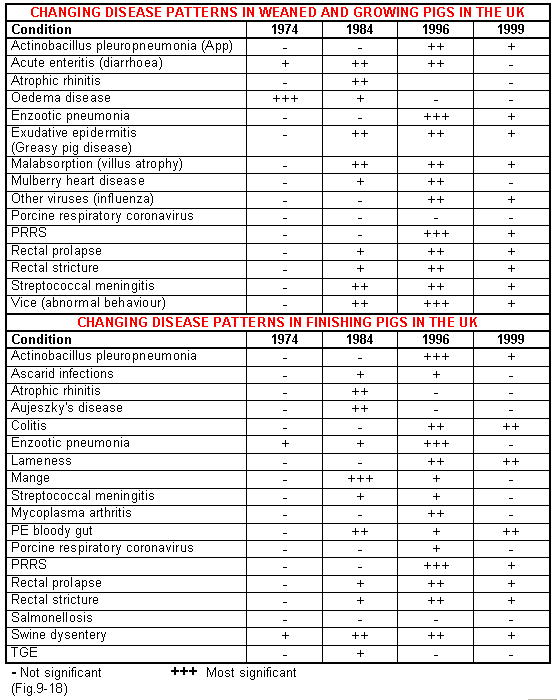



Efficient production
To maintain efficient production in the growing pig it is necessary to understand the complex interactions that are involved. There are five important areas:
- Management. The quality of this contributes to the health and biological efficiency of the pig.
- Feed. This is the major cost component of the growing pig. The efficiency of use is vital and the nutritional value versus price is very important. How it is delivered and made available to the pig can increase feed intake and maximise feed efficiency.
- The type of housing used and the quality of the environment.
- The levels of disease and their economic effects. These are significantly demonstrated by the very marked improvements in daily gain and feed conversion achieved when pigs are segregated and early weaned, or produced under segregated disease control conditions.
- The genetic potential of the pig.
The differential diagnosis of poor growth
How do we identify problems of poor growth?
This is a most difficult area to clarify and understand. Up to 75% of the total feed purchased is used from weaning to slaughter and it is surprising that so little emphasis is placed upon the efficiency of its use. The starting point is to identify those points along the pig's growth curve where targets are not met.
First of all the factors that affect the growth and feed efficiency of the pig in an intensive production system must be considered and these are listed in Fig 9-7. Study these in relation to the factors that affect profitability in Fig.9-8. In many respects they have a great deal in common. Note that planning and the use of records are considered two of the main factors because these are the starting points for the identification of poor growth rate, followed by clinical observations of the pigs on the farm. The results of any tests or post-mortem examinations, either for monitoring purposes or disease investigations, must also be appraised. Fig.9-9 collects these together at farm level for practical use.
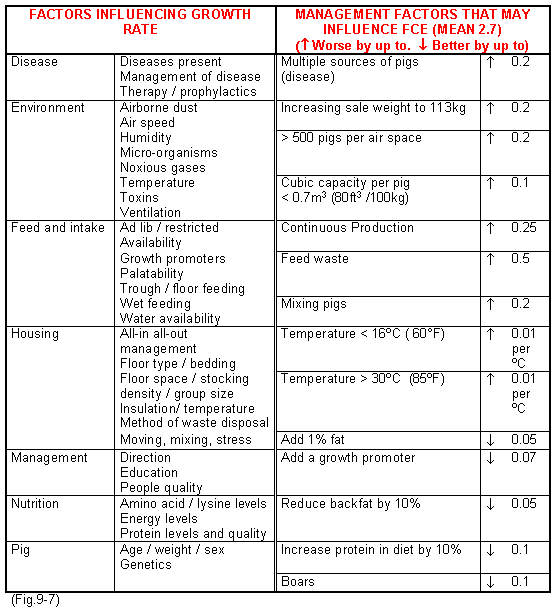
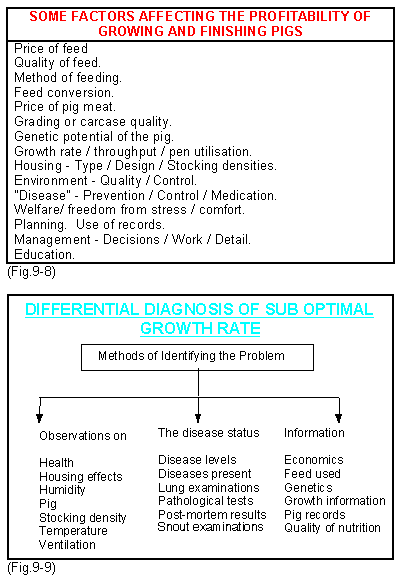
The pig
Profit comes from the margin between the price paid for the carcase and the costs that are incurred to produce it. The major cost is feed. The more feed required to produce a kg of meat then the less the profit. The genetic make up of the pig is vital in this respect. To produce 1kg of lean meat requires approximately 1.25kg of feed, whereas, to produce 1kg of fat requires approximately 4kg of feed. An animal that can convert more of its feed into lean meat therefore is much more profitable than one that converts it into fat. How often this obvious factor is neglected. Furthermore excess fat at slaughter may be severely penalised. The rate of deposition of lean meat is dependent on the sex of the animal, its genetic background, the type of feed used, the quantity fed and the disease and its effects on growth rate. A lean pig however is more susceptible to environmental change and disease.
During the past 15 years in many pig producing countries across the world there has been considerable emphasis on the selection of pigs with high lean tissue deposition that will continue through to the slaughter weight. The unimproved pig 15 years ago would maximise its lean tissue growth at around 40kg. The pig of today will maximise its lean tissue growth at the expense of fat at 60-90kg, the boar being more efficient. Always use the best sires available i.e. those with rapid growth, good feed conversion efficiency, good killing out percentage or yield and high levels of lean tissue deposition. All these traits are highly heritable.
Records
The growing period is the most difficult section on the farm from which to gather useful information. It requires the extra burden of weighing, identifying pigs, recording feed usage and objective analysis of these in relation to the cost of feed, (including medication) and carcase grading. However, such information is highly cost effective because it determines how the pig is growing during the different phases on your farm and identifies the inefficient and weak points. Monitoring is best carried out by tattooing a number in the ear for each week of birth, from which weight for age is easily determined. Alternatively a minimum of ten males and ten females should be randomly selected every one to four weeks at point of weaning and each batch tagged with different coloured tags. Such selected groups of pigs can then be weighed and assessed against age at predetermined points. It is then possible to build up a growth curve and assess both the efficient and inefficient points. A typical example is shown in Fig.9-10, where there is increasing variability in the weight of pigs as age increases. There are two distinct dips in the growth curve, one at 80 to 90 days of age and another at 130 to 140. This graph identifies two problem areas that can then be investigated further.

The use of a modern computer programme has taken a lot of hard work out of compiling information but the following are necessary to assess the efficiency of growth.
- Average liveweight gain per pig from weaning to point of sale.
- Daily gain related to age.
- Average numbers of days from weaning to point of sale.
- Amount of feed consumed per pig per day.
- Food conversion efficiency
- The price of feed.
- Feed cost per kg of liveweight gain.
Efficient growth is dependent on many factors most of which have been listed in Fig.9-7. Fig.9-11 shows growth curves that might be achieved under good conditions on the farm.
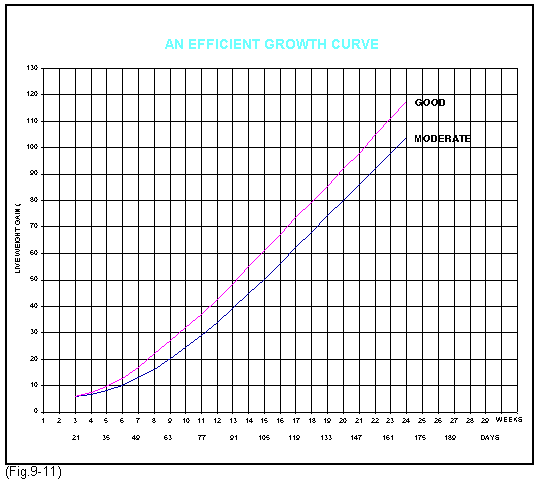
Such figures can then be compared to targets set for the farm, as suggested in Fig.9-12 and the quick reference in Fig.9-13. The density of the diet fed and its effects on feed intake and feed efficiency may vary these figures slightly.
The feed intake in some genotypes will be higher with a slight worse feed efficiency but increased gain.
Computerised pig models are also now available that will respond to theoretical changes in feed, the environment, the genetics of the pig and the cost of feed. They are not yet used widely because their results are sometimes variable and there are problems of obtaining accurate input information from the farm. However as they become more sophisticated they will provide valuable information to help identify inadequacies, look at "what if" scenarios and help to make better decisions.
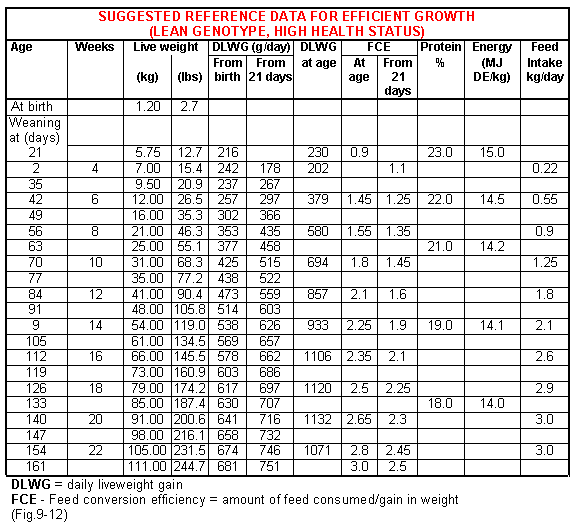
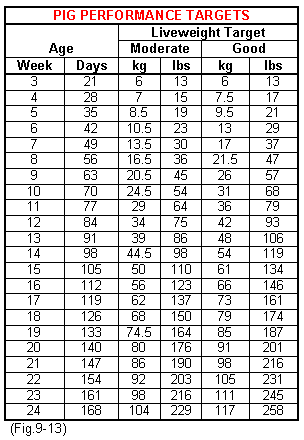
Nutrition
The way the pig utilises its feed is dependent upon its genotype, the level of available energy, the protein quality and quantity and the limiting effects of essential amino acids. Equally important however is the temperature, ventilation and humidity of the environment in the house.
It is important to provide adequate trough space to maximise growth and reduce any predisposition to disease (Fig.9-14)
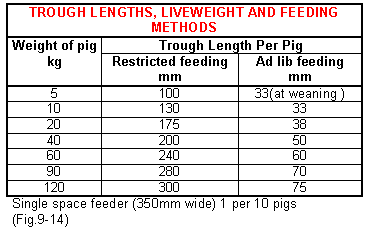
Once the rates of growth in the herd have been established assess whether target levels have been achieved and if not try to determine the reasons why. Use the checklists in chapter 3 to provide additional information.
Observation
The pig
Observations by the experienced stockperson should identify healthy and diseased pigs and those with variable growth rates.
The following should be considered when carrying out the assessment.
- Were the pigs moved into the pen as an even batch and if so is growth rate throughout the whole batch still even? This is important in relation to the presence of disease.
- Do the pigs exhibit any abnormal signs such as higher than usual levels of coughing, sneezing or skin irritation.
- Is there a history of disease or are there signs of disease?
- Do they appear settled in the pen or are there any signs of vice?
- Is the floor clean? Feed wastage can account for up to 0.4 of loss of feed conversion efficiency on some farms, particularly those that are floor feeding. Pick up a handful of feed off the floor and smell it. Has it gone rancid?
- Check the feed hoppers. It is amazing how many of them have a hole in the bottom or are of such a design that the pig scoops food out down through the slats. Waste is one of the most important factors associated with "inefficient growth".
- Is the floor wet or are the pigs wet? This will have a marked effect on the way they use energy and feed.
The environment
- Next look at the pigs on a group basis rather than individuals. Are they huddled together in a corner, or when at rest, lying on their sides not touching other pigs?
- If the latter is the case then you will know that the temperature is correct and that the airflow across the pigs is not chilling them.
- Do the skins of the animals appear shiny and pink with little hair or are they dull and dirty with excess hair growth? In the latter the pigs may be below their lower critical temperature and therefore using feed to keep warm.
- Fig.9-15 indicates the different ranges of temperatures that may be required by the pig at differing weights on different types of floor surface. The thermo-neutral zone is the temperature range within which heat production is independent of air temperature. The limits of this range are described as the upper and lower critical temperatures (UCT, LCT). When pigs are housed below their lower critical temperature a proportion of their feed is used to maintain body heat and they are more susceptible to disease. There is a marked increase in the lower critical temperature at point of weaning, due to low feed intake and the inability of the pig to satisfy its energy requirements.
An 80kg pig with restricted feed could have a lower critical temperature of 15ºC (59ºF) but if it was fed ad lib the LCT could drop to 11ºC (52ºF). At the other extreme as pigs reach the upper critical temperature, which starts to take effect above 30ºC (86ºF), heat relieving procedures come into play with fouling and wetting on the floor together with soiled food, loss of palatability resulting in reduced intake and therefore reduced growth rate. A checklist of the environmental factors that can determine the upper and lower critical temperatures is shown in Fig.9-16.
If feed conversion efficiency is poor, check the factors in Fig.9-17.
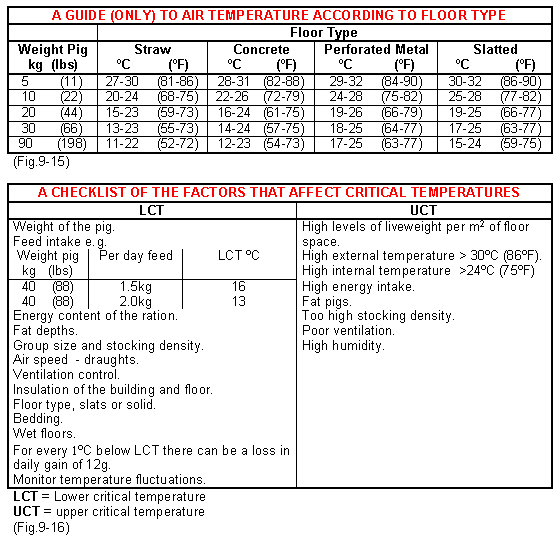
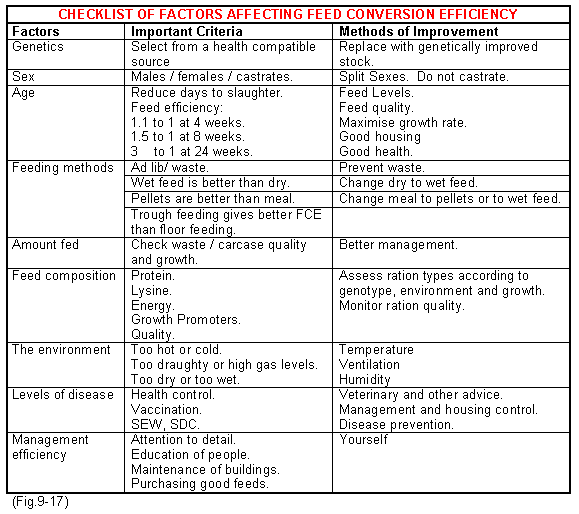
Disease
During the period of observation the veterinarian and experienced stockpeople can assess the levels and presence of different diseases and their influence on growth rate and economy of production.
Use the following checklist during the clinical examinations as described in chapter 3, to identify problem areas:
- Weight for age
- Stocking densities.
- Evenness of growth.
- Effects of nutrition on growth in different environments.
- Time of feed changes and effects.
- Effects of pig movement.
- Environment changes.
- Quality of the environment, insulation, temperatures, humidity, draughts, temperature fluctuations.
- Wet pens, dirty floors.
- Spoiled feed.
- Undigested feed evident in faeces.
- Appearance of pigs skins - mange.
- Appearance of the faeces, e.g. colitis - sloppy faeces.
- Respiratory disease.
- Enteric disease.
- Records of treatments / mortalities.
- Prolapses.
- Number of pigs culled.
- Parasites.
- Examine hospital pens.
The changes in disease patterns in growing and feeding pigs in 63 intensive pig herds during a 25 year period are shown in Fig.9-18. These show the effects that changing production systems, disease and management practices may have over time and such changes may be relevant in your herd.
Note the significant improvement in overall health from 1996 onwards. This has been associated with management, vaccination and altered pig flow such as segregated early weaning, segregated disease control and 3 site production.
